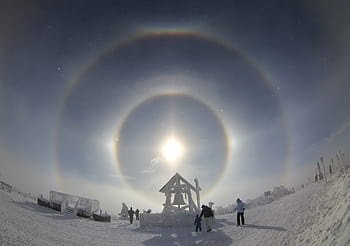News - New Education Options
Do Clouds Have Names? Is Passion for Snowflakes a Recent Phenomenon? Read GLOBE Clouds Winter Update Blog and Find Out

Halos in the Ore Mountains in Saxony, Germany
A recent Community Blog, “NASA GLOBE Clouds Winter Update,” written by Marilé Colón Robles (lead for the GLOBE Clouds Team at NASA's Langley Research Center) provides an inspiring invitation to participate in the gathering of cloud data this winter, a historical snapshot of pioneer snowflake seekers, and a bedazzled look at the link between science and art.
“Did you know that clouds have names? As the title of the GLOBE Elementary book says, clouds do have names. Those names describe the altitude and the appearance of the cloud. Cumulus means pile in Latin, so the name is used to describe low puffy clouds in the sky. Cirrus means locks of hair, and is used to describe those thin wispy clouds found high up in the sky. Some people think that nimbus is a type of cloud, but it is not. It is an affix, or a word that works as a prefix or a suffix. The affix nimbus denotes precipitation, which is rain, sleet, freezing rain and snow as the temperatures in the northern hemisphere get colder. This makes me think of a farmer in Vermont, USA who loved snow. His name was Wilson Bentley and he was always excited by snowflakes. He was so excited that he rigged up a camera he had with a microscope and took the first pictures of snowflakes ever recorded,” Robles said in the blog.
“His passion for snowflakes and ingenuity in collecting his images reminds us of the link between science and art. In these times as we discover how to do things in new and innovative ways, we seem to always come back to art.”
“Wilson, or Snowflake Bentley as he is known today, dedicated his life to photographing these beautiful snow crystals. He became a world expert on them. He had multiple publications in science journals, magazines, and newspapers. Mr. Bentley photographed 5,381 snowflakes. Each one was numbered, dated and catalogued. Wilson himself said, ‘I have yet found no exact duplicate. In this inexhaustible storehouse of crystal treasures, what a delight is in store for all future lovers of snowflakes, and of the beautiful in nature.’ Mr. Bentley’s photographs are available to look through and study.”
“The GLOBE Clouds team hopes that as you look up at the sky, you get inspired by the science and also the beauty of nature. We would love to showcase your clouds or sky inspired artwork and pictures. NASA has multiple opportunities and galleries for the connections between art and science. You may also enjoy the 2021 NASA Science calendar highlighting the beauty in nature,” Robles said.
The blog also offers a Q&A with illustrator and former NASA Intern, Steffi Walthall, who is a full-time freelance illustrator working primarily in the fields of Children's Publishing (HarperCollins, Scholastic), Education (Pearsons, Kingfisher), and Editorial illustration (NYT, New Yorker).
Walthall invites people to draw their observations. “You may not have the time to draw, but you can submit photographs with your sky observations,” Robles said in the blog. “Both drawings and photographs help create memory, especially if it is a unique day of observations. Both can also provide additional information that is not fully captured with the observation.”
In addition, in the blog, the GLOBE Clouds team highlights the work that GLOBE Malta students and teachers have put into the merging of science and art of clouds. “We invite you to view the drawings, paintings, poetry, and reflections done by GLOBE Malta participants during their cloud challenge during summer 2020,” Robles said.
As an additional inspiration, the blog focuses attention on the science topic of “ice halos.” Extending an invitation for community members to submit their halo photographs and clouds observations to GLOBE, Robles said, “Ice halos are a great thing to look for as we enter the winter months in the northern hemisphere. If you are in the southern hemisphere, no worries, you can still see some incredible halos even as you enter the summer months. Halos and other types of similar optical events tend to occur when you have cirrostratus or thin cirrus present!”
To read the entire blog – and get inspired with photos; engaged in the opportunities; and excited about past, and present, endeavors to touch the sky – click here.
News origin: GLOBE Implementation Office




